Noise is everywhere in the office.
Today’s workplaces are more open and airy than ever before. The walls of bulky office cubicles are torn down and replaced by long, shared bench desks.
This shift comes with complaints about office noise. The buzz of conversations, the clatter of keyboards, and the occasional ringtone can combine to create a cacophonous atmosphere that disrupts concentration and reduces productivity.
This guide to office soundproofing aims to provide you with practical tips, effective solutions, as well as real-world examples to reduce noise pollution and create a quieter, more productive office space. If you want to stop office noise from wrecking your work day, keep scrolling.
Table of Contents
- The Struggle to Stay Focused in a Noisy Office
- Common Sources of Office Noise
- How to Soundproof Your Office: 8 Practices
- Real-world Examples
- Conclusion
The Struggle to Stay Focused in a Noisy Office
The open office layout has caught on for its collaboration, transparency, and cost-saving for many years. Yet, it comes with its own set of challenges, the most evident being the constant struggle to main focus in a noisy, bustling environment.
In such setups, a cacophony of noise envelopes employees from all directions. This daily auditory assault often turns the office into a battleground between the need for focus and unrelenting noise.

How Noise is Affecting Your Office
The drawbacks of this persistent battle for focus in a noisy office are manifold.
- Hamper Productivity: First and foremost, productivity suffers as employees struggle to get their work done without constant interruptions. The open environment, designed for collaboration, paradoxically increases distractions that hinder deep thinking and problem-solving.
- Stress Out: The incessant chatter and auditory stimuli can lead to increased stress levels, taking a toll on employees’ health and behavior. As stress accumulates, so do errors and missed opportunities, further eroding work quality and overall employee satisfaction.
- High Employee Turnover: This is also a common consequence. As individuals seek quieter and more focused, private workspaces, leaving organizations grappling with recruitment and training costs.
Fortunately, there are remedies for these problems. With the right office soundproofing strategies in place, you can unleash your team’s full potential while improving their overall well-being.
Before we delve into the details of solutions, let’s start by identifying the sources of noise.
Common Sources of Office Noise
- Conversations: The chatter of co-workers, meetings, and phone calls can create a constant hum of background noise.
- Office Equipment: Printers, photocopiers, and other machinery produce a constant stream of disruptive sounds.
- Foot Traffic: Moving around the office, especially in high-traffic areas, can create unwanted noise.
- HVAC Systems: Heating, ventilation, and air conditioning systems often produce a steady hum that can be distracting.
- External Disturbances: Street noise, construction, or nearby businesses can also seep into your workspace.
In the following sections, we’ll explore practical tips and office soundproofing solutions to mitigate noise and create a healthier, more efficient workplace.
How to Soundproof Your Office: 8 Practices
Below are 8 effective solutions to help you reduce noise pollution in the office:
1. Create a Variety of Workspaces
The first port of call is updating your office layout and providing diverse work areas.
Open Spaces
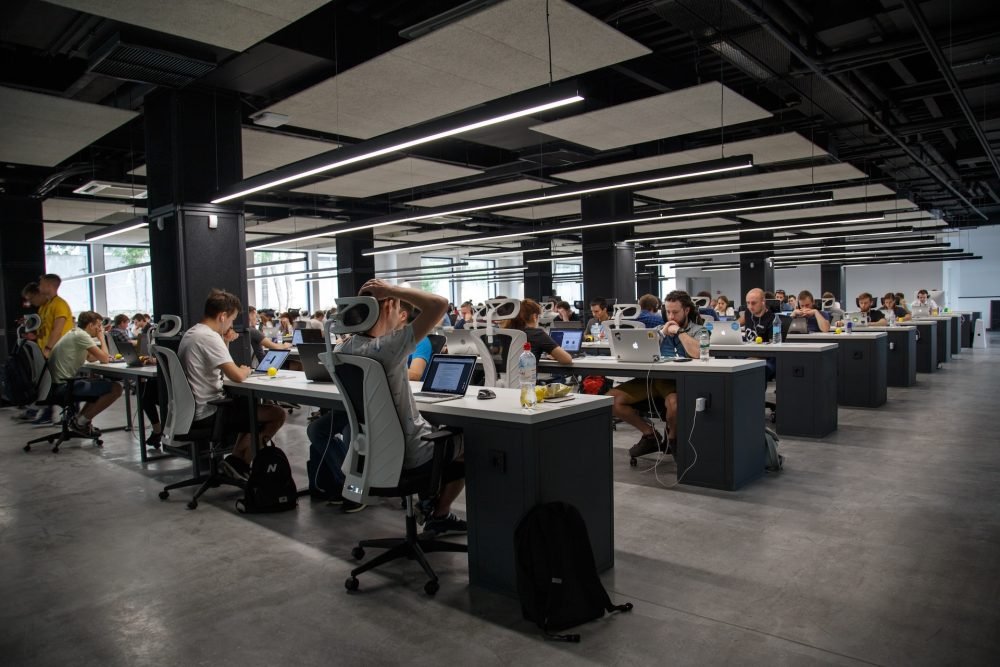
Well-designed open spaces can act as a buffer for sound.
When employees collaborate, discuss, and interact in designated open areas, the noise generated there tends to stay within that zone. This prevents noise from spilling over the quieter areas, reducing the overall noise level in the rest of the office.
Dedicated Quiet Spaces

These quiet spaces are intentionally designed to be soundproof or at least sound-resistant.
They are equipped with acoustic treatments, materials, and isolation mechanisms to reduce noise intrusion.
Dedicated quiet spaces are go-to spots for employees who need a noise-free environment to concentrate or recharge their minds. Individuals can work without being disturbed by the activities in the open areas.
Distribution of Teams
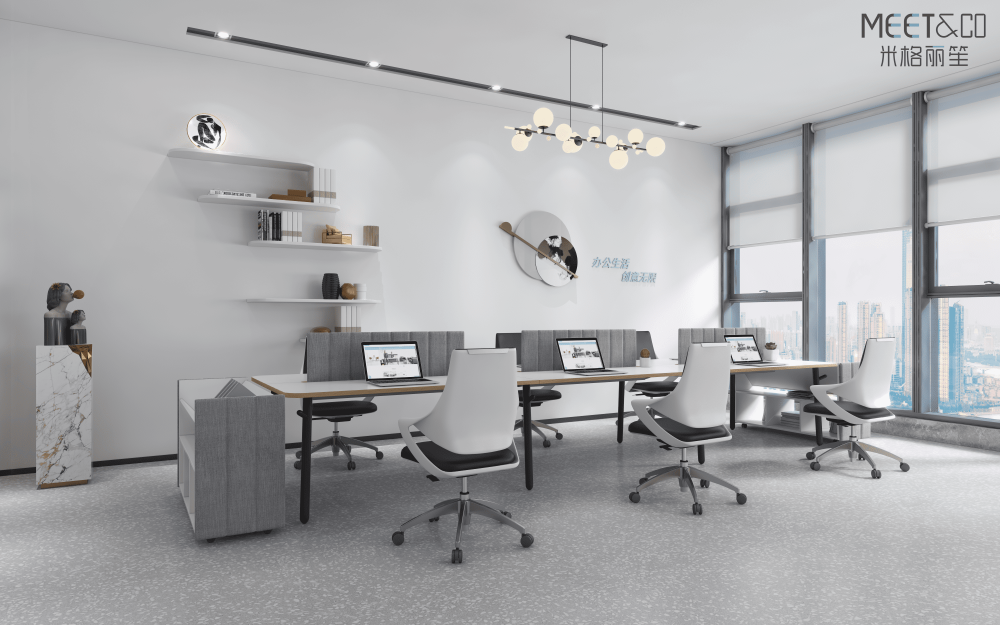
Place teams with similar noise levels in proximity. For example, teams that need to frequently collaborate can be grouped in open spaces, while teams that demand quiet can be situated in quieter areas.
Distributing teams strategically helps limit the spread of noise between departments, reducing the negative impact of noise pollution on the entire workforce.
A well-thought-out combination of different workspaces not only allows employees to work in environments that suit their tasks and preferences but also ensures that noise is generated and contained in areas where it’s most appropriate. This, in turn, contributes to a more peaceful and productive office setting.
2. Sound Absorption
Here are some common noise-reduction solutions for walls, ceilings, and flooring:
Walls
- Acoustic Panels: Installing acoustic panels on walls can absorb sound and reduce echoes, making it easier to have focused conversations and meetings.
- Wall Treatments: Textured wall coverings and materials such as cork or fabric can also help reduce noise and add an aesthetic touch to your workspace.
Ceiling
- Ceiling Tiles: Acoustic ceiling tiles are designed to absorb sound and reduce reverberation, creating a quieter environment in your office.
- Cloud Panels: Suspended acoustic cloud panels can be strategically placed to further control noise and improve acoustics.
Flooring
- Carpets and Rugs: Placing carpets with dense padding or area rugs can significantly reduce noise from foot traffic and chair movement in communal spaces or workstations.
3. Acoustic Office Pods
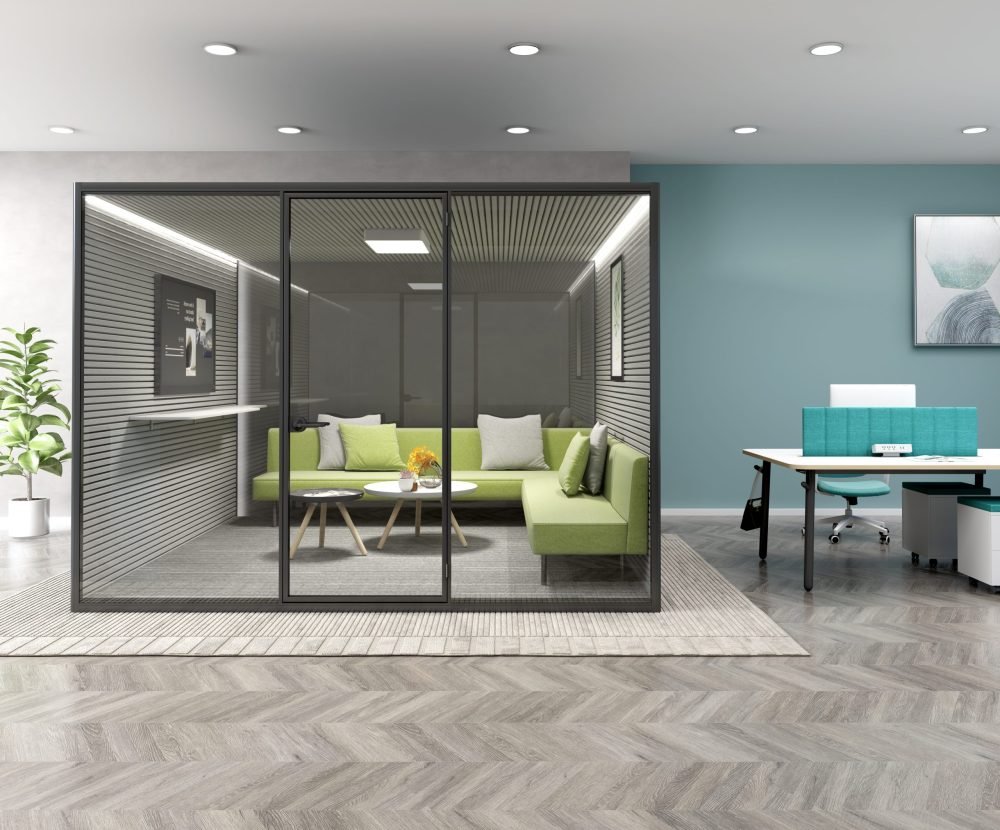
Acoustic office pods are a remarkable office soundproofing solution. These compact enclosures are built to create isolated, noise-controlled spaces within an open office layout.
These pods are typically constructed with sound-absorbing materials like foam or fabric, sealed doors, and acoustic panels. All these elements effectively trap sound within the pod while blocking external noise and conversations.
One of the key benefits of acoustic office pods is their adaptability. They can be used for focused work, team meetings, job interviews, or phone calls, allowing employees to escape the surrounding office noise and better focus on their tasks.
The result is improved productivity, reduced stress, and a better overall work experience. They are the dedicated quiet zones amid a bustling office, leading to a quieter and more harmonious work environment.
4. High Wall Partitions

High wall partitions serve as physical barriers that prevent sound from traveling from one area to another.
These partitions are typically made of dense materials and often reach ceiling height, effectively creating separate workspaces within an open office. Apart from soundproofing, they also offer visual privacy and create distinct areas for teams or departments, promoting organization and focus.
5. Movable Soundproof Glass Partitions
Movable partitions provide flexibility in defining and adjusting office areas. These partitions, often equipped with soundproof materials and solid construction, can serve as versatile tools to create private meeting rooms, collaborative spaces, or quiet work areas as needed.
6. Plants and More Plants
Indoor plants can absorb and scatter sound, reducing noise levels.
Their leaves, stems and soil are natural sound absorbers, effectively reducing noise levels in the environment.
Plants not only help dampen noise but also improve air quality, which promotes employee health and well-being. The presence of greenery also creates a visually pleasing atmosphere that reduces stress and increases productivity.
By introducing a variety of plants into the office, you create natural space dividers that not only look great but also reduce the negative impact of noise in the workspace.
7. Provide Noise-cancelling Headphones

If changing the office layout or investing in new office furniture is not an option, buying noise-canceling headphones may be the easiest way to reduce noise in your open office space.
These headphones provide a practical and portable solution for individuals to actively reduce or eliminate ambient sounds and better concentrate on tasks.
Notably, using noise-canceling headphones may create a less sociable atmosphere and limit interaction and communication among employees.
8. White Noise
Another simple way is to play white noise. White noise is a constant, low-level background sound that can mask or drown out other noise, making it less noticeable.
It’s useful for creating a consistent, less distracting background sound that helps maintain focus and productivity in an open office environment.
Real-world Examples
1. Acoustic Sofa Pods
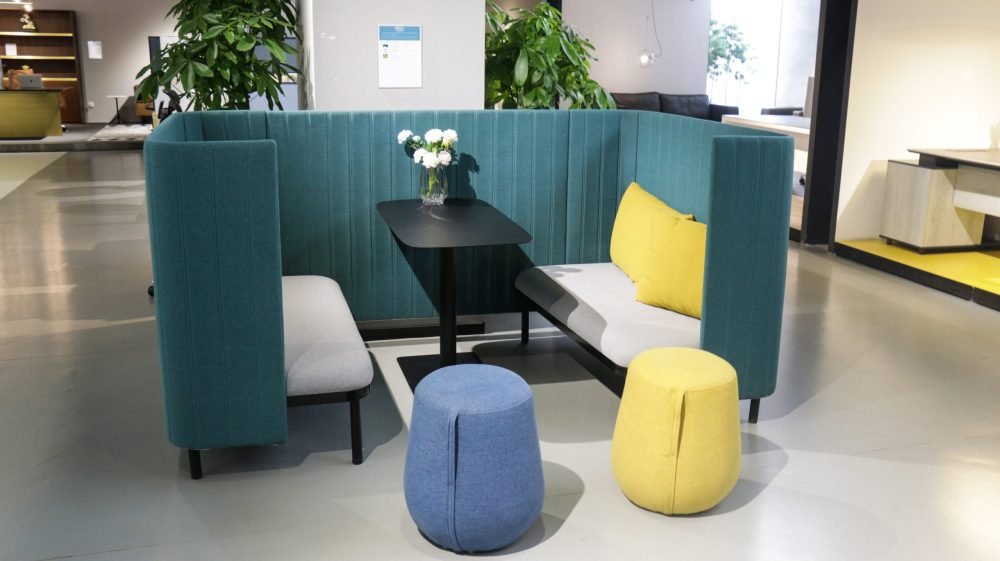
High-panel acoustic sofa pods not only reduce noise and improve privacy but also add an aesthetically pleasing touch to the workplace.
2. Movable Soundproof Glass Partitions

Meetco Furniture meeting areas: Soundproof glass partition walls provide a simplistic approach to office soundproofing and space dividing. The movable partitions can create a quieter workspace when needed and open, collaborative spaces at other times.
3. Carpeting
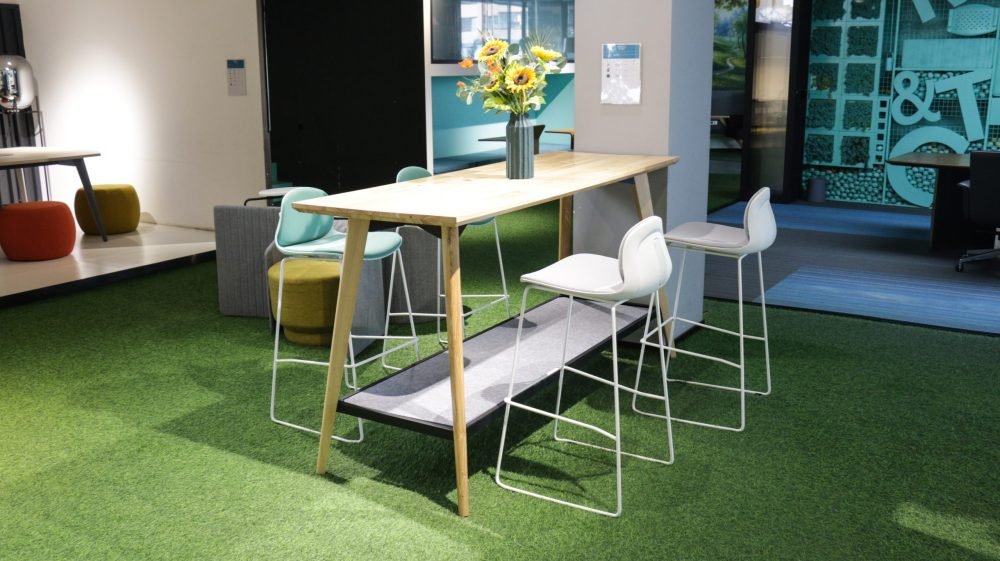
Meetco Furniture communal spaces: Use carpets to reduce noise and enhance the aesthetics of the space.
Conclusion
The importance of creating a conducive and productive workspace cannot be overstated. And office soundproofing is one of the essentials to fostering a truly efficient environment.
By understanding the importance of office soundproofing and implementing the right strategies, you can tailor your office space to meet the diverse needs of your team, ultimately creating a more conducive, harmonious work environment for all.
Need more office furniture solutions? Meetco Furniture designs and manufactures a wide range of office furniture for all businesses. Explore our collection of high-quality products, contact us for more assistance, or visit our furniture showroom. With over 15 years of experience, we’re always ready to help you create your dream workplace.
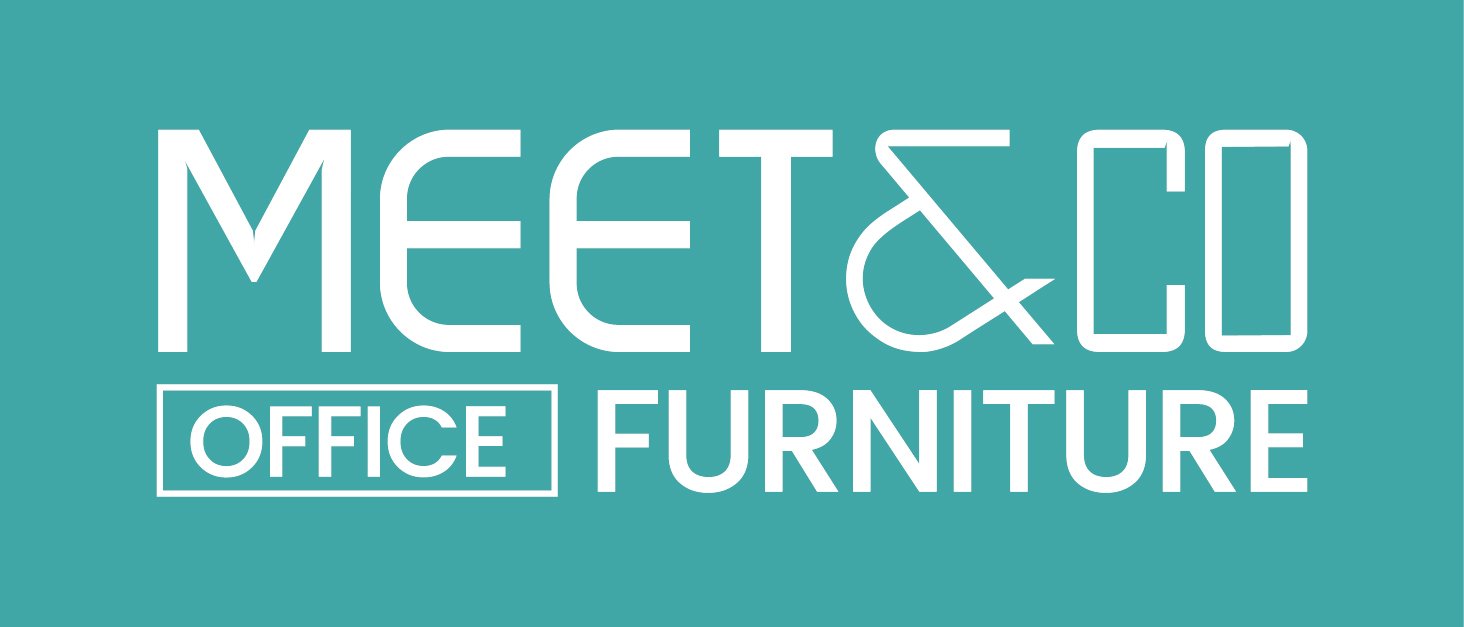
-scaled-e1702519409243.jpg)